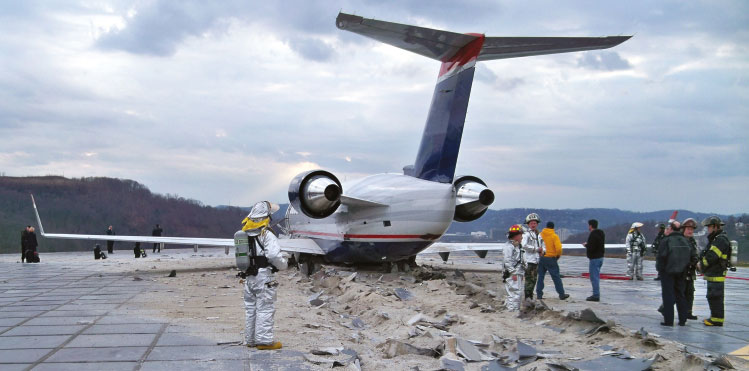
EMAS systems are a form of overrun protection for commercial airports. Placed at the end of a runway in the form of a bed that crushes under the weight of an aircraft, the EMAS decelerates the aircraft and brings it to a safe stop within the overrun area. (Photo courtesy of Yeager Airport)
Kevin Quan, Vice President, Sales & Marketing, Zodiac Aerospace, interviewed by Samantha Jenkins.
One of the most compelling reasons to consider use of an aircraft arresting system is its effectiveness in overrun protection. “Zodiac’s EMAS technology – EMASMAX – has a perfect record in stopping every single aircraft that has used it. The dependability and predictability of EMASMAX provides a high level of security and safety that airports can depend on,” Kevin Quan, Vice President, Sales & Marketing, Zodiac Aerospace, asserted. “This is only possible through Zodiac’s requirement of a high quality standard when it comes to design and manufacturing. Installation of an arresting system would also greatly reduce the footprint required and can potentially allow an airport with sufficient RESA to gain runway length.”
Zodiac Aerospace currently has four EMAS arrestor beds installed at Madrid-Barajas and Kristiansand airports. Those beds are in place and standing by to mitigate the severity of an aircraft overrun, and the company is in discussions with a number of airports throughout Europe to see how EMASMAX can be an effective solution for them.

Kevin Quan, Vice President, Sales & Marketing, Zodiac Aerospace: “Each EMASMAX bed is uniquely configured to optimised performance for the fleet mix on an airport’s specific runway.”
EMASMAX is the latest generation of Zodiac’s EMAS product, which has evolved over the last 20 years since its first installation in 1996 at New York-JFK International Airport. “Improvements to components of the product have allowed it to be more durable, more predictable in performance, and require a lower level of maintenance,” Quan commented. “We have over 100 systems installed worldwide in locations above the Arctic Circle, as well as hot and humid environments, to high altitude locations prone to excessive UV exposure.”
When the technology was first developed in the 1990s, the objective was to create a product for larger commercial service airports. However, as more and more airports saw the need for such technology, varying strengths of the product were developed to allow smaller airports without commercial service to install the arrestor beds. “In fact, some of our real-life aircraft arrestments have been at smaller airports with corporate business jets,” Quan explained. “As for the design of our arrestor beds, each EMASMAX bed is uniquely configured to optimised performance for the fleet mix on an airport’s specific runway.”
EMASMAX has stopped aircraft as large as a 747 down to as small as a Citation. Furthermore, some of these overruns occurred on a contaminated runway, which is not an issue for EMASMAX as it relies on the tyre crushing action for deceleration and not friction between the tyre and EMAS material. As an added benefit, the airports were able to bring the runway back into operations as quickly as a few hours.
Zodiac Aerospace is working on a number of innovative products to improve airport safety. “I cannot disclose what they are yet, as we are still in the development stage. What I can share with you is that we expect to be able to launch these products in the near-term,” Quan concluded.







